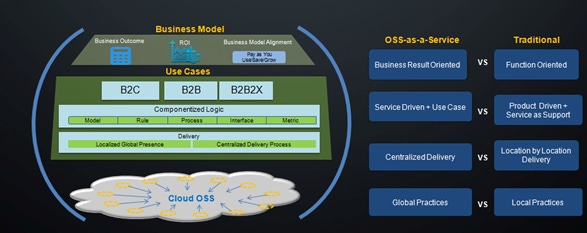The growing market for OSS-as-a-Service in telecommunications
September 17, 2015

As Communications service providers (CSPs) move towards offering more non-traditional, digital services and new business models to become Digital service providers (DSPs), they need to make their networks and software platforms more open and programmable. CSPs are starting to evolve their networks and to consolidate their operations in a move towards more agile operations models. Telecoms software delivery models are changing and we are starting to see more innovative service led models aimed at CSPs’ business outcomes as vendors seek to become the CSPs’ partners in their move to this new operating model.[1]
In order to start the move to this new operating model, CSPs need to first rationalise their OSS deployments using best of breed or best of suite solutions that can provide operational efficiency and reduction of costs, through standardisation and automation. Group CSPs are also looking to centralise and consolidate their operations to reduce costs and provide a standardised environment across all OpCos that they can then use to standardise their operations and then develop use cases that they can then deploy across all OpCos. In the process, they reduce costs and also improve operational flexibility and service agility to become more competitive in their markets. Telefonica’s ambitious transformation programme that is expected to transform its operations and position it as a digital telco is a prime example.[2]
This has led to the emergence of OSS delivery engagement models that are often services led OSS solutions delivery in different business and pricing models. Cloud subscription models and Software as a Service (SaaS) delivery models are popular for IT environments and OSS solution deliveries based on this are starting to emerge. OSS solutions can now be deployed in private clouds and delivered with consumption based or multi-year pricing that moves also moves capex to opex, leading to a characterisation of innovative models that can be classified as ‘OSS-as-a-service’. Centralised models are also becoming possible, where Group CSPs can deploy their OSS as a hosted solution in regional clouds, and standardise operations environments and use cases for their OpCos.
CSPs are embarking on OSS transformations of varying degrees starting from rationalisation of systems and legacy decommissioning, to consolidation and centralisation of systems, processes and organisational divisions. Group CSPs are leading these efforts and need long term partners who can provide them with a large portfolio of solutions and experience with managing services and large scale transformations. CSPs also need vendors capable of providing a wide range of professional services from Business consulting, design consulting, customised development for new features and use cases, systems integration and hosted managed services in addition to the standard product related services.
CSPs are also looking to move away from a large capex spend at the beginning of a project and suppliers are moving to service-led engagements which involves providing the hardware, software, SLA management services, other professional services, custom development of specific use cases etc. to cater to the CSPs’ needs for their transformation plans. The delivery of the software within that package now also has many delivery options: traditional on premise deployment, SaaS, hosted service, leased models and the licenses and services may be paid for in a subscription based model or in as a multi-year contract with spread out costs, following an extended service model where suppliers can add several features, uses cases and services to add value to the operations environment in an on-going basis.[3]
This also provides the foundation for CSPs to move their networks towards virtualisation, because there is need for a large design, system integration and custom development efforts to support software controlled networks.
Network is CSP’s important asset and is key to customer retention and acquisition
Our connected consumer survey shows that consumers rate the coverage (performance), data capability and customer service key criteria for moving to a operator or staying with an operator. CSPs need to ensure maximum customer experience and maintain their networks and services at least cost. Service assurance and service fulfilment systems are key for ensuring that the network quality is maintained. This is one of the main reasons why CSPs are transforming their operations to next generation architectures, solutions and topologies.
About the Author(s)
You May Also Like








.png?width=300&auto=webp&quality=80&disable=upscale)


_1.jpg?width=300&auto=webp&quality=80&disable=upscale)


.png?width=800&auto=webp&quality=80&disable=upscale)